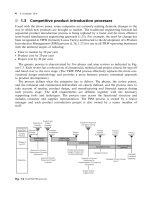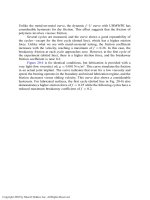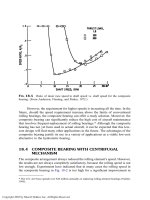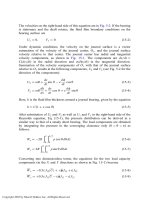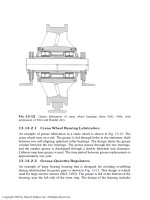Bearing Design in Machinery Episode 1 Part 2 pdf
Bạn đang xem bản rút gọn của tài liệu. Xem và tải ngay bản đầy đủ của tài liệu tại đây (243.88 KB, 18 trang )
only axial loads. A combination of radial and thrust bearings is often applied to
support the shaft in machinery.
1.1.2 Bearing Classi¢cation
Machines could not operate at high speed in their familiar way without some
means of reducing friction and the wear of moving parts. Several important
engineering inventions made it possible to successfully operate heavily loaded
shafts at high speed, including the rolling-element bearing and hydrodynamic,
hydrostatic, and magnetic bearings.
1. Rolling-element bearings are characterized by rolling motion, such as
in ball bearings or cylindrical rolling-element bearings. The advantage
of rolling motion is that it involves much less friction and wear, in
comparison to the sliding motion of regular sleeve bearings.
2. The term hydrodynamic bearing refers to a sleeve bearing or an
inclined plane-slider where the sliding plane floats on a thin film of
lubrication. The fluid film is maintained at a high pressure that supports
the bearing load and completely separates the sliding surfaces. The
lubricant can be fed into the bearing at atmospheric or higher pressure.
The pressure wave in the lubrication film is generated by hydrody-
namic action due to the rapid rotation of the journal. The fluid film acts
like a viscous wedge and generates high pressure and load-carrying
capacity. The sliding surface floats on the fluid film, and wear is
prevented.
3. In contrast to hydrodynamic bearing, hydrostatic bearing refers to a
configuration where the pressure in the fluid film is generated by an
external high-pressure pump. The lubricant at high pressure is fed into
the bearing recesses from an external pump through high-pressure
tubing. The fluid, under high pressure in the bearing recesses, carries
the load and separates the sliding surfaces, thus preventing high
friction and wear.
4. A recent introduction is the electromagnetic bearing. It is still in
development but has already been used in some unique applications.
The concept of operation is that a magnetic force is used to support the
bearing load. Several electromagnets are mounted on the bearing side
(stator poles). The bearing load capacity is generated by the magnetic
field between rotating laminators, mounted on the journal, and stator
poles, on the stationary bearing side. Active feedback control keeps the
journal floating without any contact with the bearing surface. The
advantage is that there is no contact between the sliding surfaces, so
wear is completely prevented as long as there is magnetic levitation.
Copyright 2003 by Marcel Dekker, Inc. All Rights Reserved.
Further description of the characteristics and applications of these bearings
is included in this and the following chapters.
1.2 DRY AND BOUNDARY LUBRICATION
BEARINGS
Whenever the load on the bearing is light and the shaft speed is low, wear is not a
critical problem and a sleeve bearing or plane-slider lubricated by a very thin
layer of oil (boundary lubrication) can be adequate. Sintered bronzes with
additives of other elements are widely used as bearing materials. Liquid or
solid lubricants are often inserted into the porosity of the material and make it
self-lubricated. However, in heavy-duty machinery—namely, bearings operating
for long periods of time under heavy load relative to the contact area and at high
speeds—better bearing types should be selected to prevent excessive wear rates
and to achieve acceptable bearing life. Bearings from the aforementioned list can
be selected, namely, rolling-element bearings or fluid film bearings.
In most applications, the sliding surfaces of the bearing are lubricated.
However, bearings with dry surfaces are used in unique situations where
lubrication is not desirable. Examples are in the food and pharmaceutical
industries, where the risk of contamination by the lubricant forbids its application.
The sliding speed, V, and the average pressure in the bearing, P, limit the use of
dry or boundary lubrication. For plastic and sintered bearing materials, a widely
accepted limit criterion is the product PV for each bearing material and
lubrication condition. This product is proportional to the amount of friction-
energy loss that is dissipated in the bearing as heat. This is in addition to limits on
the maximum sliding velocity and average pressure. For example, a self-
lubricated sintered bronze bearing has the following limits:
Surface velocity limit, V ,is6m=s, or 1180 ft=min
Average surface-pressure limit, P, is 14 MPa, or 2000 psi
PV limit is 110,000 psi-ft=min, or 3: 85 Â 10
6
Pa-m=s
In comparison, bearings made of plastics have much lower PV limit. This is
because the plastics have a low melting point; in addition, the plastics are not
good conductors of heat, in comparison to metals. For these reasons, the PV limit
is kept at relatively low values, in order to prevent bearing failure by overheating.
For example, Nylon 6, which is widely used as a bearing material, has the
following limits as a bearing material:
Surface velocity limit, V ,is5m=s
Average surface-pressure limit, P, is 6.9 MPa
PV limit is 105 Â10
3
Pa-m=s
Copyright 2003 by Marcel Dekker, Inc. All Rights Reserved.
Remark. In hydrodynamic lubrication, the symbol for surface velocity of
a rotating shaft is U , but for the PV product, sliding velocity V is traditionally
used.
Conversion to SI Units.
1 lbf=in:
2
ðpsiÞ¼6895 N=m
2
ðPaÞ
1ft=min ¼ 0:0051 m=s
1 psi-ft=min ¼ 6895 Â 0:0051 ¼ 35 Pa-m=s ¼ 35 Â10
À6
MPa-m=s
An example for calculation of the PV value in various cases is included at
the end of this chapter. The PV limit is much lower than that obtained by
multiplying the maximum speed and maximum average pressure due to the load
capacity. The reason is that the maximum PV is determined from considerations
of heat dissipation in the bearing, while the average pressure and maximum speed
can be individually of higher value, as long as the product is not too high. If the
maximum PV is exceeded, it would usually result in a faster-than-acceptable wear
rate.
1.3 HYDRODYNAMIC BEARING
An inclined plane-slider is shown in Fig. 1-2. It carries a load F and has
horizontal velocity, U, relative to a stationary horizontal plane surface. The plane-
slider is inclined at an angle a relative to the horizontal plane. If the surfaces were
dry, there would be direct contact between the two surfaces, resulting in
significant friction and wear. It is well known that friction and wear can be
reduced by lubrication. If a sufficient quantity of lubricant is provided and the
FIG. 1-2 Hydrodynamic lubrication of plane-slider.
Copyright 2003 by Marcel Dekker, Inc. All Rights Reserved.
sliding velocity is high, the surfaces would be completely separated by a very thin
lubrication film having the shape of a fluid wedge. In the case of complete
separation, full hydrodynamic lubrication is obtained. The plane-slider is inclined,
to form a converging viscous wedge of lubricant as shown in Fig. 1-2. The
magnitudes of h
1
and h
2
are very small, of the order of only a few micrometers.
The clearance shown in Fig. 1-2 is much enlarged.
The lower part of Fig. 1-2 shows the pressure distribution, p (pressure
wave), inside the thin fluid film. This pressure wave carries the slider and its load.
The inclined slider, floating on the lubricant, is in a way similar to water-skiing,
although the physical phenomena are not identical. The pressure wave inside the
lubrication film is due to the fluid viscosity, while in water-skiing it is due to the
fluid inertia. The generation of a pressure wave in hydrodynamic bearings can be
explained in simple terms, as follows: The fluid adheres to the solid surfaces and
is dragged into the thin converging wedge by the high shear forces due to the
motion of the plane-slider. In turn, high pressure must build up in the fluid film in
order to allow the fluid to escape through the thin clearances.
A commonly used bearing in machinery is the hydrodynamic journal
bearing, as shown in Fig. 1-3. Similar to the inclined plane-slider, it can support
a radial load without any direct contact between the rotating shaft (journal) and
the bearing sleeve. The viscous fluid film is shaped like a wedge due to the
eccentricity, e, of the centers of the journal relative to that of bearing bore. As
with the plane-slider, a pressure wave is generated in the lubricant, and a thin fluid
FIG. 1-3 Hydrodynamic journal bearing.
Copyright 2003 by Marcel Dekker, Inc. All Rights Reserved.
film completely separates the journal and bearing surfaces. Due to the hydro-
dynamic effect, there is low friction and there is no significant wear as long as a
complete separation is maintained between the sliding surfaces.
The pressure wave inside the hydrodynamic film carries the journal weight
together with the external load on the journal. The principle of operation is the
uneven clearance around the bearing formed by a small eccentricity, e, between
the journal and bearing centers, as shown in Fig. 1-3. The clearance is full of
lubricant and forms a thin fluid film of variable thickness. A pressure wave is
generated in the converging part of the clearance. The resultant force of the fluid
film pressure wave is the load-carrying capacity, W , of the bearing. For bearings
operating at steady conditions (constant journal speed and bearing load), the load-
carrying capacity is equal to the external load, F, on the bearing. But the two
forces of action and reaction act in opposite directions.
In a hydrodynamic journal bearing, the load capacity (equal in magnitude
to the bearing force) increases with the eccentricity, e, of the journal. Under
steady conditions, the center of the journal always finds its equilibrium point,
where the load capacity is equal to the external load on the journal. Figure 1-3
indicates that the eccentricity displacement, e, of the journal center, away from
the bearing center, is not in the vertical direction but at a certain attitude angle, f,
from the vertical direction. In this configuration, the resultant load capacity, due
to the pressure wave, is in the vertical direction, opposing the vertical external
force. The fluid film pressure is generated mostly in the converging part of the
clearance, and the attitude angle is required to allow the converging region to be
below the journal to provide the required lift force in the vertical direction and, in
this way, to support the external load.
In real machinery, there are always vibrations and disturbances that can
cause occasional contact between the surface asperities (surface roughness),
resulting in severe wear. In order to minimize this risk, the task of the engineer
is to design the hydrodynamic journal bearing so that it will operate with a
minimum lubrication-film thickness, h
n
, much thicker than the size of the surface
asperities. Bearing designers must keep in mind that if the size of the surface
asperities is of the order of magnitude of 1 micron, the minimum film thickness,
h
n
, should be 10–100 microns, depending on the bearing size and the level of
vibrations expected in the machine.
1.3.1 Disadvantages of Hydrodynamic Bearings
One major disadvantage of hydrodynamic bearings is that a certain minimum
speed is required to generate a full fluid film that completely separates the sliding
surfaces. Below that speed, there is mixed or boundary lubrication, with direct
contact between the asperities of the rubbing surfaces. For this reason, even if the
bearing is well designed and successfully operating at the high rated speed of the
Copyright 2003 by Marcel Dekker, Inc. All Rights Reserved.
machine, it can be subjected to excessive friction and wear at low speed, such as
during starting and stopping of journal rotation. In particular, hydrodynamic
bearings undergo severe wear during start-up, when they accelerate from zero
speed, because static friction is higher than dynamic friction.
A second important disadvantage is that hydrodynamic bearings are
completely dependent on a continuous supply of lubricant. If the oil supply is
interrupted, even for a short time for some unexpected reason, it can cause
overheating and sudden bearing failure. It is well known that motor vehicle
engines do not last a long time if run without oil. In that case, the hydrodynamic
bearings fail first due to the melting of the white metal lining on the bearing. This
risk of failure is the reason why hydrodynamic bearings are never used in critical
applications where there are safety concerns, such as in aircraft engines. Failure
of a motor vehicle engine, although it is highly undesirable, does not involve risk
of loss of life; therefore, hydrodynamic bearings are commonly used in motor
vehicle engines for their superior performance and particularly for their relatively
long operation life.
A third important disadvantage is that the hydrodynamic journal bearing
has a low stiffness to radial displacement of the journal (low resistance to radial
run-out), particularly when the eccentricity is low. This characteristic rules out the
application of hydrodynamic bearings in precision machines, e.g., machine tools.
Under dynamic loads, the low stiffness of the bearings can result in dynamic
instability, particularly with lightly loaded high-speed journals. The low stiffness
causes an additional serious problem of bearing whirl at high journal speeds. The
bearing whirl phenomenon results from instability in the oil film, which often
results in bearing failure.
Further discussions of the disadvantages of journal bearing and methods to
overcome these drawbacks are included in the following chapters.
1.4 HYDROSTATIC BEARING
The introduction of externally pressurized hydrostatic bearings can solve the
problem of wear at low speed that exists in hydrodynamic bearings. In hydrostatic
bearings, a fluid film completely separates the sliding surfaces at all speeds,
including zero speed. However, hydrostatic bearings involve higher cost in
comparison to hydrodynamic bearings. Unlike hydrodynamic bearings, where
the pressure wave in the oil film is generated inside the bearing by the rotation of
the journal, an external oil pump pressurizes the hydrostatic bearing. In this way,
the hydrostatic bearing is not subjected to excessive friction and wear rate at low
speed.
The hydrostatic operation has the advantage that it can maintain complete
separation of the sliding surfaces by means of high fluid pressure during the
starting and stopping of journal rotation. Hydrostatic bearings are more expensive
Copyright 2003 by Marcel Dekker, Inc. All Rights Reserved.
than hydrodynamic bearings, since they require a hydraulic system to pump and
circulate the lubricant and there are higher energy losses involved in the
circulation of the fluid. The complexity and higher cost are reasons that
hydrostatic bearings are used only in special circumstances where these extra
expenses can be financially justified.
Girard introduced the principle of the hydrostatic bearing in 1851. Only
much later, in 1923, did Hodgekinson patent a hydrostatic bearing having wide
recesses and fluid pumped into the recesses at constant pressure through flow
restrictors. The purpose of the flow restrictors is to allow bearing operation and
adequate bearing stiffness when all the recesses are fed at constant pressure from
one pump. The advantage of this system is that it requires only one pump without
flow dividers for distributing oil at a constant flow rate into each recess.
Whenever there are many recesses, the fluid is usually supplied at constant
pressure from one central pump. The fluid flows into the recesses through flow
restrictors to improve the radial stiffness of the bearing. A diagram of such system
is presented in Fig. 1-4. From a pump, the oil flows into several recesses around
the bore of the bearing through capillary flow restrictors. From the recesses, the
fluid flows out in the axial direction through a thin radial clearance, h
o
, between
the journal and lands (outside the recesses) around the circumference of the two
ends of the bearing. This thin clearance creates a resistance to the outlet flow from
each bearing recess. This outlet resistance, at the lands, is essential to maintain
high pressure in each recess around the bearing. This resistance at the outlet
varies by any small radial displacement of the journal due to the bearing load. The
purpose of supplying the fluid to the recesses through flow restrictors is to make
the bearing stiffer under radial force; namely, it reduces radial displacement
(radial run-out) of the journal when a radial load is applied. The following is an
explanation for the improved stiffness provided by flow restrictors.
When a journal is displaced in the radial direction from the bearing center,
the clearances at the lands of the opposing recesses are no longer equal. The
resistance to the flow from the opposing recesses decreases and increases,
respectively (the resistance is inversely proportional to h
3
o
). This results in unequal
flow rates in the opposing recesses. The flow increases and decreases, respec-
tively. An important characteristic of a flow restrictor, such as a capillary tube, is
that its pressure drop increases with flow rate. In turn, this causes the pressures in
the opposing recesses to decrease and increase, respectively. The bearing load
capacity resulting from these pressure differences acts in the opposite direction to
the radial load on the journal. In this way, the bearing supports the journal with
minimal radial displacement. In conclusion, the introduction of inlet flow
restrictors increases the bearing stiffness because only a very small radial
displacement of the journal is sufficient to generate a large pressure difference
between opposing recesses.
Copyright 2003 by Marcel Dekker, Inc. All Rights Reserved.
journal. In addition, hydrostatic journal bearings operate with relatively large
clearances (compared to other bearings); and therefore, there is not any significant
run-out that results from uneven surface finish or small dimensional errors in the
internal bore of the bearing or journal.
1.5 MAGNETIC BEARING
A magnetic bearing is shown in Fig. 1-5. The concept of operation is that a
magnetic field is applied to support the bearing load. Several electromagnets are
FIG. 1-5 Concept of magnetic bearing. Used by permission of Resolve Magnetic
Bearings.
Copyright 2003 by Marcel Dekker, Inc. All Rights Reserved.
mounted on the bearing side (stator poles). Electrical current in the stator poles
generates a magnetic field. The load-carrying capacity of the bearing is due to the
magnetic field between the rotating laminators mounted on the journal and the
coils of the stator poles on the stationary bearing side.
Active feedback control is required to keep the journal floating without its
making any contact with the bearing. The control entails on-line measurement of
the shaft displacement from the bearing center, namely, the magnitude of the
eccentricity and its direction. The measurement is fed into the controller for active
feedback control of the bearing support forces in each pole in order to keep the
journal close to the bearing center. This is achieved by varying the magnetic field
of each pole around the bearing. In this way, it is possible to control the
magnitude and direction of the resultant magnetic force on the shaft. This
closed-loop control results in stable bearing operation.
During the last decade, a lot of research work on magnetic bearings has
been conducted in order to optimize the performance of the magnetic bearing.
The research work included optimization of the direction of magnetic flux,
comparison between electromagnetic and permanent magnets, and optimization
of the number of magnetic poles. This research work has resulted in improved
load capacity and lower energy losses. In addition, research has been conducted
to improve the design of the control system, which resulted in a better control of
rotor vibrations, particularly at the critical speeds of the shaft.
1.5.1 Disadvantages of Magnetic Bearings
Although significant improvement has been achieved, there are still several
disadvantages in comparison with other, conventional bearings. The most
important limitations follow.
a. Electromagnetic bearings are relatively much more expensive than
other noncontact bearings, such as the hydrostatic bearing. In most
cases, this fact makes the electromagnetic bearing an uneconomical
alternative.
b. Electromagnetic bearings have less damping of journal vibrations in
comparison to hydrostatic oil bearings.
c. In machine tools and other manufacturing environments, the magnetic
force attracts steel or iron chips.
d. Magnetic bearings must be quite large in comparison to conventional
noncontact bearings in order to generate equivalent load capacity. An
acceptable-size magnetic bearing has a limited static and dynamic load
capacity. The magnetic force that supports static loads is limited by the
saturation properties of the electromagnet core material. The maximum
magnetic field is reduced with temperature. In addition, the dynamic
Copyright 2003 by Marcel Dekker, Inc. All Rights Reserved.
load capacity of the bearing is limited by the available electrical power
supply from the amplifier.
e. Finally, electromagnetic bearings involve complex design problems to
ensure that the heavy spindle, with its high inertia, does not fall and
damage the magnetic bearing when power is shut off or momentarily
discontinued. Therefore, a noninterrupted power supply is required to
operate the magnetic bearing, even at no load or at shutdown condi-
tions of the system. In order to secure safe operation in case of
accidental power failure or support of the rotor during shutdown of
the machine, an auxiliary bearing is required. Rolling-element bearings
with large clearance are commonly used. During the use of such
auxiliary bearings, severe impact can result in premature rolling-
element failure.
1.6 ROLLING-ELEMENT BEARINGS
Rolling-element bearings, such as ball, cylindrical, or conical rolling bearings, are
the bearings most widely used in machinery. Rolling bearings are often referred
to as antifriction bearings. The most important advantage of rolling-element
bearings is the low friction and wear of rolling relative to that of sliding.
Rolling bearings are used in a wide range of applications. When selected
and applied properly, they can operate successfully over a long period of time.
Rolling friction is lower than sliding friction; therefore, rolling bearings have
lower friction energy losses as well as reduced wear in comparison to sliding
bearings. Nevertheless, the designer must keep in mind that the life of a rolling-
element bearing can be limited due to fatigue. Ball bearings involve a point
contact between the balls and the races, resulting in high stresses at the contact,
often named hertz stresses, after Hertz (1881), who analyzed for the first time the
stress distribution in a point contact.
When a rolling-element bearing is in operation, the rolling contacts are
subjected to alternating stresses at high frequency that result in metal fatigue. At
high speed, the centrifugal forces of the rolling elements, high temperature (due
to friction-energy losses) and alternating stresses all combine to reduce the
fatigue life of the bearing. For bearings operating at low and medium speeds,
relatively long fatigue life can be achieved in most cases. But at very high speeds,
the fatigue life of rolling element bearings can be too short, so other bearing types
should be selected. Bearing speed is an important consideration in the selection of
a proper type of bearing. High-quality rolling-element bearings, which involve
much higher cost, are available for critical high-speed applications, such as in
aircraft turbines.
Over the last few decades, a continuous improvement in materials and the
methods of manufacturing of rolling-element bearings have resulted in a
Copyright 2003 by Marcel Dekker, Inc. All Rights Reserved.
significant improvement in fatigue life, specifically for aircraft applications. But
the trend in modern machinery is to increase the speed of shafts more and more in
order to reduce the size of machinery. Therefore, the limitations of rolling-
element bearings at very high speeds are expected to be more significant in the
future.
The fatigue life of a rolling bearing is a function of the magnitude of the
oscillating stresses at the contact. If the stresses are low, the fatigue life can be
practically unlimited. The stresses in dry contact can be calculated by the theory
of elasticity. However, the surfaces are usually lubricated, and there is a very thin
lubrication film at very high pressure separating the rolling surfaces. This thin
film prevents direct contact and plays an important role in wear reduction. The
analysis of this film is based on the elastohydrodynamic (EHD) theory, which
considers the fluid dynamics of the film in a way similar to that of hydrodynamic
bearings.
Unlike conventional hydrodynamic theory, EHD theory considers the
elastic deformation in the contact area resulting from the high-pressure distribu-
tion in the fluid film. In addition, in EHD theory, the lubricant viscosity is
considered as a function of the pressure, because the pressures are much higher
than in regular hydrodynamic bearings. Recent research work has considered the
thermal effects in the elastohydrodynamic film. Although there has been much
progress in the understanding of rolling contact, in practice the life of the rolling-
element bearing is still estimated by means of empirical equations. One must
keep in mind the statistical nature of bearing life. Rolling bearings are selected to
have a very low probability of premature failure. The bearings are designed to
have a certain predetermined life span, such as 10 years. The desired life span
should be determined before the design of a machine is initiated.
Experience over many years indicates that failure due to fatigue in rolling
bearings is only one possible failure mode among many other, more frequent
failure modes, due to various reasons. Common failure causes include bearing
overheating, misalignment errors, improper mounting, corrosion, trapped hard
particles, and not providing the bearing with proper lubrication (oil starvation or
not using the optimum type of lubricant). Most failures can be prevented by
proper maintenance, such as lubrication and proper mounting of the bearing.
Fatigue failure is evident in the form of spalling or flaking at the contact surfaces
of the races and rolling elements. It is interesting to note that although most
rolling bearings are selected by considering their fatigue life, only 5% to 10% of
the bearings actually fail by fatigue.
At high-speed operation, a frequent cause for rolling bearing failure is
overheating. The heat generated by friction losses is dissipated in the bearing,
resulting in uneven temperature distribution in the bearing. During operation, the
temperature of the rolling bearing outer ring is lower than that of the inner ring. In
turn, there is uneven thermal expansion of the inner and outer rings, resulting in
Copyright 2003 by Marcel Dekker, Inc. All Rights Reserved.
thermal stresses in the form of a tight fit and higher contact stresses between the
rolling elements and the races. The extra contact stresses further increase the level
of friction and the temperature. This sequence of events can lead to an unstable
closed-loop process, which can result in bearing failure by seizure. Common
rolling-element bearings are manufactured with an internal clearance to reduce
this risk of thermal seizure.
At high temperature the fatigue resistance of the metal is deteriorating.
Also, at high speed the centrifugal forces increase the contact stresses between the
rolling elements and the outer race. All these effects combine to reduce the
fatigue life at very high speeds. Higher risk of bearing failure exists whenever the
product of bearing load, F, and speed, n, is very high. The friction energy is
dissipated in the bearing as heat. The power loss due to friction is proportional to
the product Fn, similar to the product PV in a sleeve bearing. Therefore, the
temperature rise of the bearing relative to the ambient temperature is also
proportional to this product. In conclusion, load and speed are two important
parameters that should be considered for selection and design purposes. In
addition to friction-energy losses, bearing overheating can be caused by heat
sources outside the bearing, such as in the case of engines or steam turbines.
In aircraft engines, only rolling bearings are used. Hydrodynamic or
hydrostatic bearings are not used because of the high risk of a catastrophic
(sudden) failure in case of interruption in the oil supply. In contrast, rolling
bearings do not tend to catastrophic failure. Usually, in case of initiation of
damage, there is a warning noise and sufficient time to replace the rolling bearing
before it completely fails. For aircraft turbine engines there is a requirement for
ever increasing power output and speed. At the very high speed required for gas
turbines, the centrifugal forces of the rolling elements become a major problem.
These centrifugal forces increase the hertz stresses at the outer-race contacts and
shorten the bearing fatigue life.
The centrifugal force is proportional to the second power of the angular
speed. Similarly, the bearing size increases the centrifugal force because of its
larger rolling-element mass as well as its larger orbit radius. The DN value
(rolling bearing bore, in millimeters, times shaft speed, in revolutions per minute,
RPM) is used as a measure for limiting the undesired effect of the centrifugal
forces in rolling bearings. Currently, the centrifugal force of the rolling elements
is one important consideration for limiting aircraft turbine engines to 2 million
DN.
Hybrid bearings, which have rolling elements made of silicon nitride and
rings made of steel, have been developed and are already in use. One important
advantage of the hybrid bearing is that the density of silicon nitride is much lower
than that of steel, resulting in lower centrifugal force. In addition, hybrid bearings
have better fatigue resistance at high temperature and are already in use for many
industrial applications. Currently, intensive tests are being conducted in hybrid
Copyright 2003 by Marcel Dekker, Inc. All Rights Reserved.
bearings for possible future application in aircraft turbines. However, due to the
high risk in this application, hybrid bearings must pass much more rigorous tests
before actually being used in aircraft engines.
Thermal stresses in rolling bearings can also be caused by thermal
elongation of the shaft. In machinery such as motors and gearboxes, the shaft
is supported by two bearings at the opposite ends of the shaft. The friction energy
in the bearings increases the temperature of the shaft much more than that of the
housing of the machine. It is important to design the mounting of the bearings
with a free fit in the housing on one side of the shaft. This bearing arrangement is
referred to as a locating=floating arrangement; it will be explained in Chapter 13.
This arrangement allows for a free thermal expansion of the shaft in the axial
direction and elimination of the high thermal stresses that could otherwise
develop.
Rolling-element bearings generate certain levels of noise and vibration, in
particular during high-speed operation. The noise and vibrations are due to
irregular dimensions of the rolling elements and are also affected by the internal
clearance in the bearing.
1.7 SELECTION CRITERIA
In comparison to rolling-element bearings, limited fatigue life is not a major
problem for hydrodynamic bearings. As long as a full fluid film completely
separates the sliding surfaces, the life of hydrodynamic bearings is significantly
longer than that of rolling bearings, particularly at very high speeds.
However, hydrodynamic bearings have other disadvantages that make other
bearing types the first choice for many applications. Hydrodynamic bearings can
be susceptible to excessive friction and wear whenever the journal surface has
occasional contact with the bearing surface and the superior fluid film lubrication
is downgraded to boundary or mixed lubrication. This occurs at low operating
speeds or during starting and stopping, since hydrodynamic bearings require a
certain minimum speed to generate an adequate film thickness capable of
completely separating the sliding surfaces.
According to the theory that is discussed in the following chapters, a very
thin fluid film is generated inside a hydrodynamic bearing even at low journal
speed. But in practice, due to surface roughness or vibrations and disturbances, a
certain minimum speed is required to generate a fluid film of sufficient thickness
that occasional contacts and wear between the sliding surfaces are prevented.
Even at high journal speed, surface-to-surface contact may occur because of
unexpected vibrations or severe disturbances in the system.
An additional disadvantage of hydrodynamic bearings is a risk of failure if
the lubricant supply is interrupted, even for a short time. A combination of high
speed and direct contact is critical, because heat is generated in the bearing at a
Copyright 2003 by Marcel Dekker, Inc. All Rights Reserved.
very fast rate. In the case of unexpected oil starvation, the bearing can undergo a
catastrophic (sudden) failure. Such catastrophic failures are often in the form of
bearing seizure (welding of journal and bearing) or failure due to the melting of
the bearing lining material, which is often a white metal of low melting
temperature. Without a continuous supply of lubricant, the temperature rises
because of the high friction from direct contact.
Oil starvation can result from several causes, such as failure of the oil pump
or the motor. In addition, the lubricant can be lost due to a leak in the oil system.
The risk of a catastrophic failure in hydrodynamic journal bearings is preventing
their utilization in important applications where safety is involved, such as in
aircraft engines, where rolling-element bearings with limited fatigue life are
predominantly used.
For low-speed applications and moderate loads, plain sleeve bearings with
boundary lubrication can provide reliable long-term service and can be an
adequate alternative to rolling-element bearings. In most industrial applications,
these bearings are made of bronze and lubricated by grease or are self-lubricated
sintered bronze. For light-duty applications, plastic bearings are widely used. As
long as the product of the average pressure and speed, PV , is within the specified
design values, the two parameters do not generate excessive temperature.
If plain sleeve bearings are designed properly, they wear gradually and do
not pose the problem of unexpected failure, such as fatigue failure in rolling-
element bearings. When they wear out, it is possible to keep the machine running
for a longer period before the bearing must be replaced. This is an important
advantage in manufacturing machinery, because it prevents the financial losses
involved in a sudden shutdown. Replacement of a plain sleeve bearing can, at
least, be postponed to a more convenient time (in comparison to a rolling
bearing). In manufacturing, unexpected shutdown can result in expensive loss
of production. For sleeve bearings with grease lubrication or oil-impregnated
porous metal bearings, the manufacturers provide tables of maximum speed and
load as well as maximum PV value, which indicate the limits for each bearing
material. If these limits are not exceeded, the temperature will not be excessive,
resulting in a reliable operation of the bearing. A solved problem is included at
the end of this chapter.
Sleeve bearings have several additional advantages. They can be designed
so that it is easier to mount and replace them, in comparison to rolling bearings.
Sleeve bearings can be of split design so that they can be replaced without
removing the shaft. Also, sleeve bearings can be designed to carry much higher
loads, in comparison to rolling bearings, where the load is limited due to the high
‘‘hertz’’stresses. In addition, sleeve bearings are usually less sensitive than rolling
bearings to dust, slurry, or corrosion caused by water infiltration.
However, rolling bearings have many other advantages. One major advan-
tage is their relatively low-cost maintenance. Rolling bearings can operate with a
Copyright 2003 by Marcel Dekker, Inc. All Rights Reserved.
minimal quantity of lubrication. Grease-packed and sealed rolling bearings are
very convenient for use in many applications, since they do not require further
lubrication. This significantly reduces the maintenance cost.
In many cases, machine designers select a rolling bearing only because it is
easier to select from a manufacturer’s catalogue. However, the advantages and
disadvantages of each bearing type must be considered carefully for each
application. Bearing selection has long-term effects on the life of the machine
as well as on maintenance expenses and the economics of running the machine
over its full life cycle. In manufacturing plants, loss of production is a dominant
consideration. In certain industries, unplanned shutdown of a machine for even 1
hour may be more expensive than the entire maintenance cost or the cost of the
best bearing. For these reasons, in manufacturing, bearing failure must be
prevented without consideration of bearing cost. In aviation, bearing failure can
result in the loss of lives; therefore, careful bearing selection and design are
essential.
1.8 BEARINGS FOR PRECISION APPLICATIONS
High-precision bearings are required for precision applications, mostly in
machine tools and measuring machines, where the shaft (referred to as the
spindle in machine tools) is required to run with extremely low radial or axial run-
out. Therefore, precision bearings are often referred to as precision spindle
bearings. Rolling bearings are widely used in precision applications because in
most cases they provide adequate precision at reasonable cost.
High-precision rolling-element bearings are manufactured and supplied in
several classes of precision. The precision is classified by the maximum allowed
tolerance of spindle run-out. In machine tools, spindle run-out is undesirable
because it results in machining errors. Radial spindle run-out in machine tools
causes machining errors in the form of deviation from roundness, while axial run-
out causes manufacturing errors in the form of deviation from flat surfaces.
Rolling-element bearing manufacturers use several tolerance classifications, but
the most common are the following three tolerance classes of precision spindle
bearings (FAG 1986):
Maximum
Precision class run-out (mm)
1. High-precision rolling-element bearings 2.0
2. Special-precision bearings 1.0
3. Ultraprecision bearings 0.5
Copyright 2003 by Marcel Dekker, Inc. All Rights Reserved.
Detailed discussion of rolling-element bearing precision is included in
Chapter 13. Although rolling-element bearings are widely used in high-precision
machine tools, there is an increasing requirement for higher levels of precision.
Rolling-element bearings always involve a certain level of noise and vibrations,
and there is a limit to their precision. The following is a survey of other bearing
types, which can be alternatives for high precision applications
1.9 NONCONTACT BEARINGS FOR PRECISION
APPLICATIONS
Three types of noncontact bearings are of special interest for precision machin-
ing, because they can run without any contact between the sliding surfaces in the
bearing. These noncontact bearings are hydrostatic, hydrodynamic, and electro-
magnetic bearings. The bearings are noncontact in the sense that there is a thin
clearance of lubricant or air between the journal (spindle in machine tools) and
the sleeve. In addition to the obvious advantages of low friction and the absence
of wear, other characteristics of noncontact bearings are important for ultra-high-
precision applications. One important characteristic is the isolation of the spindle
from vibrations. Noncontact bearings isolate the spindle from sources of vibra-
tions in the machine or even outside the machine. Moreover, direct contact
friction can induce noise and vibrations, such as in stick-slip friction; therefore,
noncontact bearings offer the significant advantage of smooth operation for high-
precision applications. The following discussion makes the case that hydrostatic
bearings are the most suitable noncontact bearing for high-precision applications
such as ultra-high-precision machine tools.
The difference between hydrodynamic and hydrostatic bearings is that, for
the first, the pressure is generated inside the bearing clearance by the rotation
action of the journal. In contrast, in a hydrostatic bearing, the pressure is supplied
by an external pump. Hydrodynamic bearings have two major disadvantages that
rule them out for use in machine tools: (a) low stiffness at low loads, and (b) at
low speeds, not completely noncontact, since the fluid film thickness is less than
the size of surface asperities.
In order to illustrate the relative advantage of hydrostatic bearings, it is
interesting to compare the nominal orders of magnitude of machining errors in
the form of deviation from roundness. The machining errors result from spindle
run-out. Higher precision can be achieved by additional means to isolate the
spindle from external vibrations, such as from the driving motor. In comparison
to rolling-element bearings, experiments in hydrostatic-bearings indicated the
following machining errors in the form of deviation from roundness by machine
tools with a spindle supported by hydrostatic bearings (see Donaldson and
Patterson, 1983 and Rowe, 1967):
Copyright 2003 by Marcel Dekker, Inc. All Rights Reserved.
Precison class Machining
error (mm)
1. Regular hydrostatic bearing 0.20
2. When vibrations are isolated from the drive 0.05
Experiments indicate that it is important to isolate the spindle from
vibrations from the drive. Although a hydrostatic bearing is supported by a
fluid film, the film has relatively high stiffness and a certain amount of vibrations
can pass through, so additional means for isolation of vibrations is desirable. The
preceding figures illustrate that hydrostatic bearings can increase machining
precision, in comparison to precision rolling bearings, by one order of magnitude.
The limits of hydrostatic bearing technology probably have not been reached yet.
1.10 BEARING SUBJECTED TO FREQUENT
STARTS AND STOPS
In addition to wear, high start-up friction in hydrodynamic journal bearings
increases the temperature of the journal much more than that of the sleeve, and
there is a risk of bearing seizure. There is uneven thermal expansion of the journal
and bearing, and under certain circumstances the clearance can be completely
eliminated, resulting in bearing seizure. Bearing seizure poses a higher risk than
wear, since the failure is catastrophic. This is the motivation for much research
aimed at reducing start-up friction.
According to hydrodynamic theory, a very thin fluid film is generated even
at low journal speed. But in practice, due to surface roughness, vibrations, and
disturbances, a certain high minimum speed is required to generate an adequate
film thickness so that occasional contacts and wear between the sliding surfaces
are prevented. The most severe wear occurs during starting because the journal is
accelerated from zero velocity, where there is relatively high static friction. The
lubricant film thickness increases with speed and must be designed to separate the
journal and sleeve completely at the rated speed of the machine. During starting,
the speed increases, the fluid film builds up its thickness, and friction is reduced
gradually.
In applications involving frequent starts, rolling element bearings are
usually selected because they are less sensitive to wear during start-up and
stopping. But this is not always the best solution, because rolling bearings have a
relatively short fatigue-life when the operating speed is very high. In Chapter 18,
it is shown that it is possible to solve these problems by using a ‘‘composite
Copyright 2003 by Marcel Dekker, Inc. All Rights Reserved.
bearing,’’ which is a unique design of hydrodynamic and rolling bearings in
series (Harnoy and Rachoor, 1993).
Manufacturers continually attempt to increase the speed of machinery in
order to reduce its size. The most difficult problem is a combination of high
operating speed with frequent starting and stopping. At very high speed, the life
of the rolling-element bearing is short, because fatigue failure is partly deter-
mined by the number of cycles, and high speed results in reduced life (measured
in hours). In addition to this, at high speed the centrifugal forces of the rolling
elements (balls or rollers) increase the fatigue stresses. Furthermore, the
temperature of the bearing rises at high speeds; therefore, the fatigue resistance
of the material deteriorates. The centrifugal forces and temperature exacerbate the
problem and limit the operating speed at which the fatigue life is acceptable. Thus
the two objectives, longer bearing life and high operating speed, are in conflict
when rolling-element bearings are used. Hydrodynamic bearings operate well at
high speeds but are not suitable for frequent-starting applications.
Replacing the hydrodynamic bearing with an externally pressurized hydro-
static bearing can eliminate the wear and friction during starting and stopping.
But a hydrostatic bearing is uneconomical for many applications, since it requires
an oil pump system, an electric motor, and flow restrictors in addition to the
regular bearing system. An example of a unique design of a composite bearing—
hydrodynamic and rolling bearings in series—is described in chapter 18. This
example is a low-cost solution to the problem involved when high-speed
machinery are subjected to frequent starting and stopping.
In conclusion, the designer should keep in mind that the optimum operation
of the rolling bearing is at low and moderate speeds, while the best performance
of the hydrodynamic bearing is at relatively high speeds. Nevertheless, in
aviation, high-speed rolling-element bearings are used successfully. These are
expensive high-quality rolling bearings made of special steels and manufactured
by unique processes for minimizing impurity and internal microscopic cracks.
Materials and manufacturing processes for rolling bearings are discussed in
Chapter 13.
1.11 EXAMPLE PROBLEMS
Example Probl em 1-1
PV Limits
Consider a shaft supported by two bearings, as shown in Fig. 1-6. The two
bearings are made of self-lubricated sintered bronze. The bearing on the left side
is under radial load, F
r
¼ 1200 lbf , and axial load, F
a
¼ 0:5F
r
. (The bearing on
the right supports only radial load). The journal diameter is D ¼ 1 inch, and the
Copyright 2003 by Marcel Dekker, Inc. All Rights Reserved.

